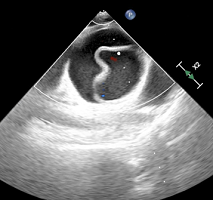1. Komolafe EO, Faniran E. Tension pneumocephalus – a rare but treatable cause of rapid neurological deterioration in traumatic brain injury: A case report. Afr J Neursci. 2010; 2: 9. doi: 10.4314/ajns.v29i2.70412
2. Solomiichuk VO, Lebed VO, Drizhdov KI. Posttraumatic delayed subdural tension pneumocephalus. Surg Neurol Int. 2013; 4: 37. doi: 10.4103/2152-7806.109537
3. Chandran TH, Prepageran N, Philip R, Gopala K, Zubaidi AL, Jalaludin MA. Delayed spontaneous traumatic pneumocephalus. Med J Malaysia. 2007; 62: 411-412.
4. Cho HL, Han YM, Hong YK. Tension pneumocephalus after transsphenoidal surgery: Report of two cases. J. Korean Neurosurg. Soc. 2004; 35: 536-538.
5. Dandy WE. Pneumocephalus (intracranial pneumatocele or aerocele). Arch. Surg. 1926; 12: 949-982. doi: 10.1001/archsurg.1926.01130050003001
6. Pandit UA, Mudge BJ, Keller TS, et al. Pneumocephalus after posterior fossa exploration in the sitting position. Anaesthesia. 1982; 37: 996-1001. doi: 10.1111/j.1365-2044.1982.tb01711.x
7. Nayak PK, Mahapatra AK. Tension pneumocephalus in lateral position following posterior fossa surgery. Pan Arab J Neurosurg. 2011; 15: 76-78.
8. Vikram A, Deb AK. Tension pneumocephalus secondary to a dural tear. Appl. Radiol. 2011; 40: 37-38. doi: 10.37549/AR1815
9. Kozikowski GP, cohen SP. Lumbar puncture associated with pneumocephalus: Report of case. Anesth Analg. 2004; 98: 524-526. doi: 10.1213/01.ANE.0000095153.75625.1F
10. Shaikh N, Masood I, Hanssens Y, Louon A, Hafiz A. Tension pneumocephalus as complication of burr-hole drainage of chronic subdural hematoma: A case report. Surg Neurol Int. 2010; 1: 27. doi: 10.4103/2152-7806.65185
11. Thapa A, Agrawal D. Mount Fuji sign in tension pneumocephalus. Indian Journal of Neurotrauma. 2009; 6: 161-163.
12. Vitali AM, le Roux AA. Tension pneumocephalus as a complication of intracranial pressure monitoring: A case report. Indian Journal of Neurotrauma. 2007; 4: 115-118. doi: 10.1016/S0973-0508(07)80025-6
13. Nolan RB, Manseri DA, Pesce D. Pneumocephalus after epidural injections. J Emerg Med. 2008; 25: 416. doi: 10.1136/emj.2006.044412
14. Katz Y, Markovits R, Rosenberg B. Pneumocephalos after inadervent intrathecal air injection during epidural block. Anesthesiology. 1990; 73: 1277-1279. doi: 10.1097/00000542-199012000-00034
15. Katz JA, Lukin R, Bridenbaugh PO, Gunzenhauser L. Subdural intracranial air: An unusual cause of headache after epidural steroid injection. Anesthesiology. 1991; 74: 615-617.
16. Ash KM, Cannon JE, Biehl DR. Pneumocephalus following attempted epidural anaesthesia. Can J Anaesth. 1991; 38: 772-774. doi: 10.1007/BF03008458
17. Michel SJ, The Mount Fuji sign. Radiology. 2004; 232: 449-450. doi: 10.1148/radiol.2322021556
18. Gautam S, Rastogi V, Jain A, Singh AP. Comparative evaluation of oxygen-ozone therapy and combined use of oxygen-ozone therapy with percutaneous intradiscal radiofrequency thermocoagulation for the treatment of lumbar disc hearniation. Pain Pract. 2011; 11: 160-166. doi: 10.1111/j.1533-2500.2010.00409.x
19. Magaihaes FN, Dotta L, Sasse A, Teixera MJ, Fonoff ET. Ozone therapy as a treatment for low back pain secondary to herniated disc: A systemic review and meta-analysis of randomised controlled trials. Pain Physician. 2012; 15: E115-E129. doi: 10.36076/ppj.2012/15/E115
20. Toman H1, Özdemir U, Kiraz HA, Lüleci N. Severe headache following ozone therapy: Pneumocephalus. Agri. 2017; 29: 132-136. doi: 10.5505/agri.2016.36024
21. Liu H, Wang Y, An JX Williums JP, Cope DK. Thunderclap headche caused by an inadervent epidural puncture during oxygen -ozone therapy for patients with cervical disc herniation. Chin Med J. 2016; 129: 498-499. doi: 10.4103/0366‑6999.176080










